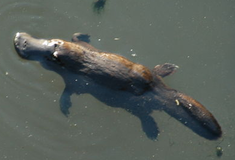
Animals of the Week #6: Australia and New Zealand
First published: Tuesday February 8th, 2022
Report this blog
Introduction
We finally made it to the next Animals of the Week blog, a feature where I educate you about [usually] six animals, to educate you about the uniqueness and beauty of our planet's zoological life. This blog is the second of what I hope to be a long-running series of thematic blogs that focus on animals from a certain region - as always, we'll be covering one mammal, bird, reptile, amphibian, fish, and invertebrate (though I do tend to occasionally bend the rules). The first-ever poll to decide the next blog in the series (this one), was closely contested and between the polar regions of the world and Australia and New Zealand, I chose Australia and New Zealand, which you may know for having riveting wildlife. Without further ado, let's delve deeper into some distinct species of Southern Oceania.
Mammal: Duck-billed Platypus
When one thinks of the vast mammalian wildlife of Australia, hundreds of images are conjured, of iconic animals, like the kangaroo, koala, or perhaps dingo. And while we've come to expect uniqueness from the incredibly biodiverse continent of Australia, what animals can rival the idiosyncrasy of the duck-billed platypus? I'm willing to wager that a good amount of you readers know what a platypus is, but there's a lot of unknown, fascinating information about this creature yet to be known, so let's dive in.
Where do we begin? Let's start with the fact that platypuses (not platypi) are not typical mammals. You see, the class of mammals is split into three groups: placental mammals, with babies that develop inside their mothers' bellies, marsupials, which conceive not-fully-developed babies that are then protected within a pouch (like kangaroos), and the last group is monotremes. Platypuses are one of two species of monotreme, along with the spiny anteater-like echidna, which means that they are actually an egg-laying mammal (unlike virtually every species and subspecies of mammal) with one opening for reproduction and waste elimination. Platypuses seem like a hundred animals combined into one at first glance (in fact, the first scientists to lay eyes upon platypuses though they were hoaxes, combined from multiple animals), with bills that strongly resemble those of ducks, beaver-like tales, a body similar to an otter or mole, and on top of all that, they are one of few venomous mammals, equipped with sharp toxic stingers on the heels of males' hind feet.
Platypuses are found in Eastern Australia and Tasmania, inhabiting streams and rivers from a huge variety of terrestrial habitats ranging from frigid highlands to tropical jungles, although they have been reputed to venture into estuaries. The monotremes are bottom-feeders, using its tail and webbed feet for propelled water travel, with a diet of insects, shellfish, and worms. Platypuses' bills contain watertight nostrils that allow them to hold their breath for two minutes while foraging, as well as specialized nerve endings known as electroreceptors that detect minuscule electric currents caused by prey. Interestingly enough, due to its lack of teeth, the platypus stores its food within cheek pouches and subsequently mashes up its meal with acquired bits of gravel. Female platypuses in underground burrows dug near the water's edge; babies hatch after ten days and nurse for up to four months until they can finally hunt independently. And to top all this off, the Australian nation considers the platypus so remarkable that the platypus is honored on the country's 20-cent coin.
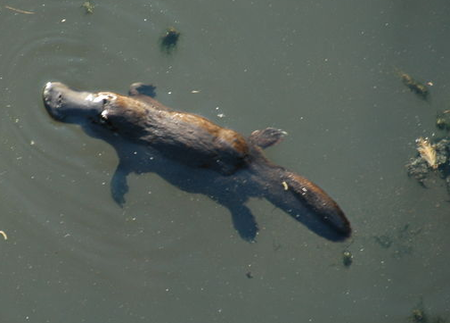
Bird: Kakapo
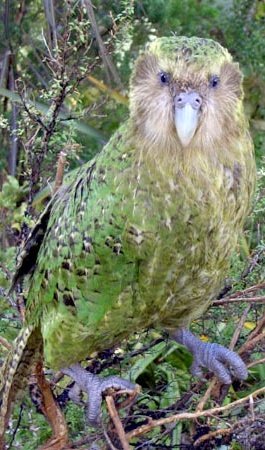
Obviously, Australia is widely well-known for having extraordinary and unique wildlife (as exhibited by the aforementioned platypus), but I wanted to give New Zealand some of the spotlight, so let's talk about this green avian. Kakapo are another flightless bird (in a previous edition, we came across the rhea), nocturnal and fairly large. It's also not an easy task to classify them, as they have no close relatives. With a pale face resembling an owl's in some way and a gray bill and legs, the feathered bodies of kakapo are moss-green in coloration with some hints of yellow and black. Males weigh about 2-4 kilograms (around 4-9 pounds) and females come in at 1-2.5 kilograms (or something like 2-5.5 pounds). The story of the species' distribution and endangerment throughout history is an interesting one: kakapo were once abundant throughout New Zealand before the arrival of the Maori people lowered their numbers and vanquished their North Island population. Kakapo survived in the moist areas of the South Island until the last of them died out in the 1980s - however, a declining population (due in part to introduced cats) of under 200 was discovered on Stewart Island, NZ, and have since been transferred to other islands for protection. As of June 2020, just 210 of these birds remain in the wild, and all are closely monitored to ensure the species' survival. Adult kakapo are vulnerable to cats and stoats, and their eggs by rats, which is partially causing their low population, as well as their low fertility and uncommon breeding (it only happens once every 2-4 years. Virtually free of predators, the kakapo may be able to endure, but who knows for how long ...?
Reptile: Inland Taipan
Perhaps Australia is most well-known for their fear-inspiring collection of snakes (even though it's a highly exaggerated misconception that snakes cause thousands of deaths in Australia per year), but when it comes to the inland taipan, its sheer ability can be exceedingly petrifying to some, which we'll get to later. The inland taipan's color ranges from a yellowish-brown hue to dark brown, with a considerable darker head and neck area, though their color changes seasonally, growing darker in winter and fading in summer. Average body lengths for adults are about 2 meters (6.5 feet) with a maximum of 2.7 meters (8.8 feet). Inland taipans shelter themselves within cracks, crevices, holes, or burrows of other animals of floodplains although they can also venture into dunes, rocky deserts, and rocky outcrops as long as they provide reasonable coverage. They are distributed across pockets of northern, central, and western Australia, some areas being coastal, throughout the subdivisions of New South Wales, Northern Territory, South Australia, and Queensland. The diurnal snake's diet consists of primarily small-to-medium mammals, rodents and small marsupials in particular, and their hunting strategy is to corner their prey in an underground section like a burrow and subsequently inflict their rapid venom upon their prey through several bites, all the information we have previously covered is far from the most noteworthy about this creature.
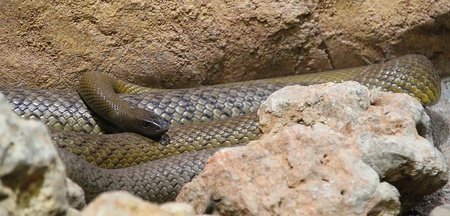
The inland taipan is believed to have the most venomous bite of any snake that has been officially recorded, meaning it the most toxic and most potent venom of any of the hundreds of venomous snakes out there, with extreme symptoms. But, if you're planning on visiting Australia (or you live there) and this is a greatly frightening prospect ... fear not! These taipans are rarely encountered in the wild due to there remote, isolated habitats and their limited appearance above the ground. In addition, they are also quite shy (at least in comparison to their aggressive cousin the coastal taipan) and are generally regarded as docile and placid by keepers that have encountered the species. And finally, though the bite of an inland taipan is extremely severe and potentially life-threating, requiring immediate medical attention, there have been very little people bitten by this snake, and all those who have faced such a danger were provided with quick medical treatment and therefore survived. The International Union for Conservation of Nature (IUCN, and this is the last time I'm spelling out the entire unabbreviated name) considers its status as Least Concern, so as long as we leave it alone and it does the same, the inland taipan will continue to survive in the remote Australian outback, undisturbed. [Sorry for the long paragraph]
Amphibian: N/A
Please excuse the absence of the amphibian section. Unique amphibians for different regions are difficult to find, and there were unfortunately limited options for frogs, salamanders, newts, and caecilians of Oceania. Thus I apologize for the now-recurring missing amphibians on the Animals of the Week series.
Fish: Freshwater Sawfish
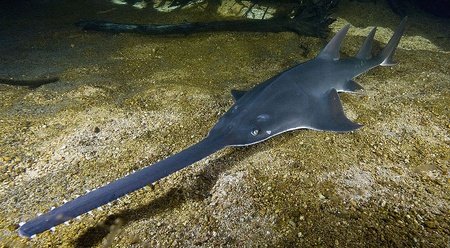
Just about everyone should know that the world really has some bizarre fish species, but when it comes to the freshwater sawfish, also known as the largetooth sawfish, you can't really get more bizarre. The sawfish's body is generally yellow-brown, greenish, or gray on the upper, more prominent side, while their underside is entirely pale-white. This fairly large shark-like ray species has a fascinating feature that I'm sure you all have noticed - a slender, flattened snout known as a rostrum with twenty teeth jutting out, sort of like a saw (the name makes sense, doesn't it?). Their eyes are located on the top of their head to ensure sight during muddy situations, with nostrils, a mouth, and gills located on their underside, resembling a stingray in that aspect. In addition, they have sizeable triangular pectoral fins located on either side of their body and tall, pointed dorsal fins located on their back. Their maximum size has, quite astoundingly been reported to be around 20-21.5 feet (6-6.6 meters) in lenght with a weight of 1100 to 1400 pounds, or approximately 500 to 635 kilograms. The nocturnal bottom-dwellers forage during the night and rest at the bottom in the day, using their rostrum for several purposes, including digging in sediment for food, attacking prey, and self-defense. Freshwater sawfish mainly consume crustaceans, mollusks, and the like, though schools of fish (such as herring or mullet) make for easy prey with the sawfish thrashing its snout from side to side. They use their rostrums, with electro-and-motion-sensitive pores, to detect movement of their prey, and their eyesight is actually quite good, though it is not very effective as the water is often murky. Listed as Critically Endangered, though the precise number is not known, freshwater sawfish are found in marine, brackish, and freshwater bodies, at depths up to 30 feet (9.1 meters), found throughout the Atlantic Ocean, the eastern Pacific, East Africa to Indonesia, India, the Philippines, New Guinea, and Australia. So, Aussies, watch out for this when you go for a swim!
Invertebrate: Geography Cone
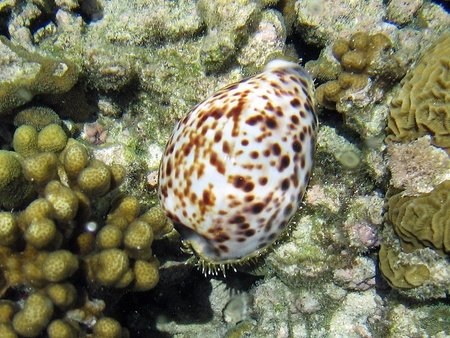
Let's talk about cone snails! Cone snails in general belong to the family Conidae, and by extension the genus Conus, and there are over 1,000 species of them dispersed across marine reefs throughout the oceans of the world. So is a snail going to be interesting? These aquatic gastropods (snails) are chiefly characterized by a cone-like shell (no surprise there) and some pretty beautiful shell patterns. Also, every single one of the species of cone snails are venomous, possessing a sharp tooth capable of injecting a potent neurotoxin that is dangerous to humans. So whatever you do, in the unlikely event you come across a cone snail, don't touch it! We've determined the defining traits of cone snails, mostly their astoundingly powerful venom, so what else is there? Why don't we talk about the most venomous of all hundreds of cone snails, the geography cone?
There is not much information on National Geographic about the geography cone, but it is an interesting species nonetheless from a reliable source. They are native to the reefs of the Indo-Pacific, specifically places like the Red Sea, the waters around East Africa and Madagascar, and, of course, Australia's coasts. 4-6 inches in length, with highly prized intricate brown-and-white-patterned shells, as previously mentioned, geography cones are the most venomous of the plethora of cone snails, with several human deaths attributed to this species. Their deathly venom is an elaborate amalgamation of hundreds of different toxins delivered from a harpoon-resembling tooth that is impelled from a proboscis (in this case, a long, extendable, flexible tube. Currently there is no antivenin for the snail's venom and treatment is limited simply to keeping victims alive until the effects abate. However, ironically the deadly venom that can cause imminent death and paralysis also has enormous potential, when isolated, for pain-killing drugs. Research shows that proteins found in said venom are extremely potent for the aforementioned pain-killing purpose.
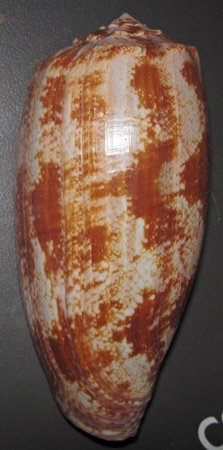
And that's the geography cone for you, with some background about the broad invertebrate family of cone snails that are probably some of the world's most dangerous snails. (Did that sound weird?)
Conclusion
Wow, this took a long time to come out. When was the last edition? November 23? Sorry for being so lazy, guys, but finally the 6th AOTW edition is out. I hope you enjoyed learning about some of the species of Australia and New Zealand (mostly Australia, because, well, it's Australia), and next time you go to Australia, you'd better not be petrified to death about snakes and all those other deadly species, because it's a rare occurrence to meet them but it can still happen. Now, with that said, how about I let you vote for the next thematic edition of AOTW, and which region the featured animals will pertain to? Here are our three options:

Polar Regions: 5
please post the next one soon lol:)I'll vote for the Polar Regions.
I'll vote for the polar regions.
good blog tho welcome back :)
wow, thanks for getting rid of the amphibian section for meMy vote would be for Polar regions, and hope that you happen to find an amphibian just to prove Ethaboo wrong ;)
and also yes I really do want to